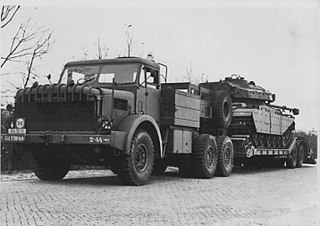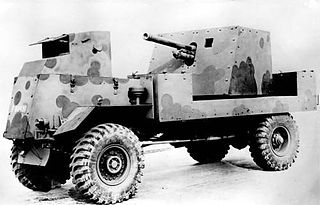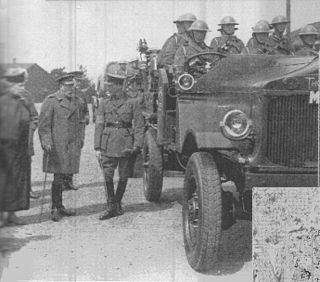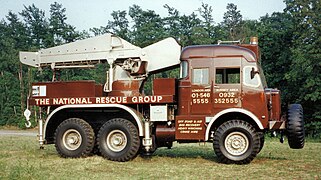
The Casspir is a Mine-Resistant Ambush Protected Vehicle that has been in use in South Africa since the 1980s. It is a four-wheeled, four-wheel drive vehicle, used for transport of troops. It can hold a crew of two, plus 12 additional soldiers and associated equipment. The Casspir was unique in design when launched, providing for passive mine defence. The main armoured steel body of the vehicle is raised high above the ground, so when a mine is detonated, the explosion is less likely to damage the crew compartment and kill the occupants. The cross-section of the hull is V-shaped (V-hull), directing the force of the explosion outwards, further protecting the occupants. The vehicle also offers crew protection from small arms fire. The capabilities of the Casspir were the basis of the outline capabilities required by the U.S. Marines' for their Mine Resistant Ambush Protected or MRAP vehicle project.

Associated Equipment Company (AEC) was a British vehicle manufacturer that built buses, motorcoaches and trucks from 1912 until 1979. The name Associated Equipment Company was hardly ever used; instead it traded under the AEC and ACLO brands.

AEC Armoured Car is the name of a series of British heavy armoured cars built by the Associated Equipment Company (AEC) during World War II.

The Medium Tactical Vehicle Replacement (MTVR) is a series of vehicles, based on a common chassis that vary by payload and mission requirements. The MTVR is a purpose-designed military vehicle, although a small number of vehicles have been sold commercially for specialized operations such as wildfire fighting.

The Mighty Antar was a heavy-duty 6×4 tractor unit built by Thornycroft from the late 1940s onwards. For some decades it was the standard tank transporter of the British Army and was also used by other nations. It was powered by a shortened V8 land version of the V12 Merlin Aircraft engine modified to run on diesel and known as the Rolls-Royce Meteorite.

Thornycroft was an English vehicle manufacturer which built coaches, buses, and trucks from 1896 until 1977.
Scammell Lorries Limited was a British manufacturer of trucks, particularly specialist and military off-highway vehicles, between 1921 and 1988.

The Morris Commercial C8 FAT, commonly known as a Quad, is an artillery tractor used by the British and Commonwealth forces during the Second World War. It was used to tow field artillery pieces, such as the 25-pounder gun-howitzer, and anti-tank guns, such as the 17-pounder.

The AEC Matador was a heavy 4×4 truck and medium artillery tractor built by the Associated Equipment Company for British and Commonwealth forces during World War II. AEC had already built a 4×2 lorry, also known as the Matador.

An artillery tractor, also referred to as a gun tractor, is a specialized heavy-duty form of tractor unit used to tow artillery pieces of varying weights and calibres. It may be wheeled, tracked, or half-tracked.

The AEC Mk I Gun Carrier, known as Deacon, was a British armoured fighting vehicle of the Second World War. It was an attempt to make the QF 6 pounder anti-tank gun into a self-propelled artillery piece. It was employed only during the North African Campaign from 1942 to 1943.

The M19 Tank Transporter was a heavy tank transporter system used in World War II and into the 1950s. It consisted of a 12-ton 6x4 M20 Diamond T Model 980 truck and companion 12-wheel M9 trailer.

An articulated hauler, articulated dump truck (ADT), or sometimes a dump hauler, is a very large heavy duty type of dump truck used to transport loads over rough terrain, and occasionally on public roads. The vehicle usually has all-wheel drive and consists of two basic units: the front section, generally called the tractor, and the rear section that contains the dump body, called the hauler or trailer section. Steering is made by pivoting the front in relation to the back by hydraulic rams. This way, all wheels follow the same path, making it an excellent off-road vehicle.

The Scammell Pioneer was a British 6×4 tractor unit used in World War II as an artillery tractor, recovery vehicle and tank transporter.

Eight-wheel drive, often notated as 8WD or 8×8, is a drivetrain configuration that allows all eight wheels of an eight-wheeled vehicle to be drive wheels simultaneously. Unlike four-wheel drive drivetrains, the configuration is largely confined to heavy-duty off-road and military vehicles, such as all-terrain vehicles, armored vehicles, and prime movers. Other types of smaller 8x8 vehicles include such things as the Argocat.

A tank transporter is a combination of a heavy tractor unit and a mating full trailer or semi-trailer, used for transporting tanks and other AFVs. Some also function as tank recovery vehicles, the tractors of which may be armored for protection in combat conditions.

The Hathi was an early four wheel drive lorry built by Thornycroft in the 1920s. It was used by the British Army as an artillery tractor.

The Mack M123 (G792) was a 10-ton 6x6 semi-tractor introduced in 1955; the Mack M125 was a heavy cargo truck version of the M123. The M123 was used to tow tank transporter trailers while the M125 towed field artillery pieces.

The Logistic Vehicle System Replacement (LVSR) is a family of heavy-duty military logistics vehicles of the United States Marine Corps (USMC) based on a common 5-axle ten-wheel drive (10x10) chassis. The vehicles vary in individual configuration by mission requirements, with three variants in service: a cargo, a wrecker and a tractor truck. The LVSR was designed and is manufactured by Oshkosh Defense.




















